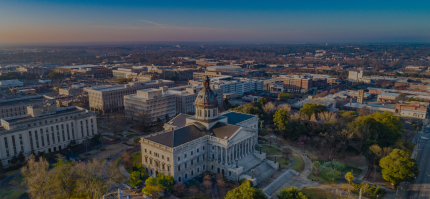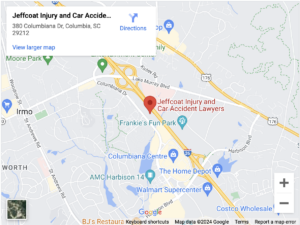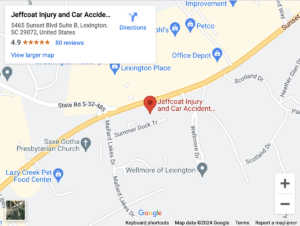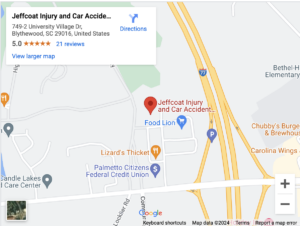November 17, 2025 | Motorcycle Accidents

The Reality of Lane Splitting Accidents in South Carolina
Picture this: You’re stuck in heavy traffic on Interstate 26 near Columbia, watching motorcycles weave between lanes of stopped cars. Suddenly, there’s a collision – a car door opens or a vehicle changes lanes unexpectedly, and a motorcyclist goes down. If you’ve been injured in a motorcycle accident while lane splitting in South Carolina, you’re likely facing a complex legal situation that requires immediate attention and understanding of state traffic laws.
Lane splitting, the practice of riding a motorcycle between two lanes of traffic moving in the same direction, remains a controversial and legally ambiguous practice across most of the United States. For motorcyclists in South Carolina who have been involved in accidents while lane splitting, understanding your legal standing and potential liability is crucial for protecting your rights and pursuing any compensation you may deserve.
💡 Pro Tip: Document everything immediately after a lane splitting accident – take photos of your position between lanes, skid marks, and vehicle positions before anything is moved. This evidence can be crucial in determining fault percentages.
Have questions about your lane splitting accident case? Jeffcoat Injury and Car Accident Lawyers are ready to explore your options and help you navigate the complexities of South Carolina traffic laws. Reach out today at (803) 200-2000 or contact us to ensure your rights are protected.
Understanding Your Rights When a South Carolina Motorcycle Accident Lawyer Reviews Lane Splitting Cases
South Carolina law does not explicitly authorize lane splitting, placing it in a gray area that can significantly impact accident liability determinations. When a South Carolina motorcycle accident lawyer evaluates these cases, they must carefully examine how the state’s comparative negligence laws apply to accidents that occur during lane splitting maneuvers. Unlike California, which has legalized the practice under specific conditions, South Carolina treats lane splitting as neither explicitly legal nor illegal, creating unique challenges for injured motorcyclists.
The absence of clear lane splitting legislation means that fault determination often depends on the specific circumstances of each accident. Insurance companies and courts will examine factors such as the motorcyclist’s speed relative to traffic, the width of the lane gap, weather conditions, and the actions of other drivers involved. Even though investigators and insurance adjusters frequently assign primary fault to the lane-splitting motorcyclist, this doesn’t mean you’re automatically barred from recovery – South Carolina’s modified comparative negligence rule allows recovery as long as you’re less than 51% at fault.
Several key factors can help demonstrate that a motorcyclist isn’t entirely responsible for a lane splitting accident. If you were riding at a reasonable speed differential (typically no more than 10-15 mph faster than surrounding traffic), maintaining a straight path without weaving, and the other driver made an abrupt lane change without signaling or checking mirrors, you may have a stronger case for shared liability. Your experience level, completion of motorcycle safety courses, and adherence to other traffic laws also play crucial roles in liability assessment.
💡 Pro Tip: Keep records of any motorcycle safety courses you’ve completed and maintain a clean driving record – these can be powerful evidence of your responsibility as a rider when challenging fault determinations.
The Legal Process Timeline After a Lane Splitting Accident
Understanding the timeline of events following a lane splitting accident helps injured motorcyclists prepare for what lies ahead. The process typically begins immediately at the accident scene and can extend for months or even years, depending on the complexity of your case and the severity of injuries. Working with a South Carolina motorcycle accident lawyer early in this process ensures you meet all critical deadlines and preserve essential evidence that could impact your ability to recover compensation.
- Immediate Response (0-72 hours): Call 911, seek medical attention even for minor injuries, document the scene thoroughly, and avoid admitting fault or discussing lane splitting with insurance adjusters
- Initial Investigation (1-4 weeks): Police complete their report, insurance companies begin investigations, and you should consult with an attorney before giving recorded statements – insurance adjusters specifically look for admissions about lane splitting
- Medical Documentation (Ongoing): Continue all recommended treatment and maintain detailed records – gaps in treatment can be used to minimize your injury claims, especially in contested lane splitting cases
- Legal Filing Deadline: South Carolina’s statute of limitations for personal injury claims is three years from the accident date – missing this deadline completely bars your right to compensation regardless of fault
- Settlement Negotiations (3-18 months): Most cases resolve through negotiation, but lane splitting accidents often face initial resistance from insurers who assume automatic motorcyclist fault
💡 Pro Tip: Start a daily journal immediately after your accident documenting pain levels, mobility limitations, and how injuries affect your daily life – this contemporaneous record becomes powerful evidence of damages that mere medical records can’t fully capture.
Building Your Case with Experienced Legal Representation
Successfully resolving a lane splitting accident claim requires strategic case building that addresses the inherent bias against motorcyclists who engage in this practice. Jeffcoat Injury and Car Accident Lawyers understand the unique challenges these cases present and work to shift focus from the lane splitting itself to the negligent actions of other drivers that contributed to the collision. This approach involves gathering comprehensive evidence including traffic camera footage, witness statements from other motorcyclists familiar with safe lane splitting practices, and accident reconstruction expert testimony.
The resolution process often involves negotiating with multiple insurance companies, each trying to shift maximum blame onto the lane-splitting motorcyclist. Experienced attorneys counter these tactics by highlighting specific negligent behaviors of other drivers – such as illegal lane changes, distracted driving, or failure to signal – that created the dangerous situation regardless of the motorcyclist’s position between lanes. They also emphasize that lane splitting, while not explicitly authorized, isn’t prohibited under South Carolina law, meaning it shouldn’t automatically assign full fault to the motorcyclist.
Many motorcyclists injured in lane splitting accidents accept lowball settlements because they believe their case has no merit, but this assumption often proves incorrect. When you consult a lawyer who understands both motorcycle dynamics and South Carolina’s comparative negligence laws, you may discover that other drivers bear significant responsibility for creating the hazardous conditions that led to your accident. Even in cases where you share some fault for lane splitting, recovering 49% of your damages is far better than accepting nothing based on incorrect assumptions about automatic liability.
💡 Pro Tip: Request copies of all traffic camera footage immediately – many systems only retain recordings for 30-90 days, and this evidence often shows driver behaviors that contradict their statements about the accident.
Critical Factors That Influence Lane Splitting Accident Outcomes
The outcome of lane splitting accident cases often hinges on specific factors that courts and insurance companies weigh when determining fault percentages. Understanding these factors helps motorcyclists and their attorneys build stronger cases for shared liability rather than accepting full blame. Traffic conditions at the time of the accident play a crucial role – lane splitting in stopped traffic presents different liability considerations than splitting between vehicles moving at 45 mph. Courts generally view lower speed differentials more favorably, recognizing that slow-speed lane splitting poses less inherent danger than high-speed maneuvers.
Environmental conditions significantly impact fault determinations in lane splitting accidents. Poor visibility due to rain, fog, or darkness makes lane splitting inherently more dangerous and can increase the motorcyclist’s fault percentage. However, these same conditions also heighten other drivers’ duty of care when changing lanes or opening doors. A South Carolina motorcycle accident lawyer will examine weather reports, lighting conditions, and road surface quality to build a comprehensive picture of how environmental factors contributed to the collision beyond just the act of lane splitting itself.
The Role of Vehicle Positioning and Driver Awareness
Vehicle positioning at the time of impact provides crucial evidence about fault distribution. Accidents occurring near the front of vehicles often indicate the motorcyclist had established their position between lanes before the other driver’s negligent action, while impacts near the rear of vehicles might suggest the motorcyclist was actively passing when the collision occurred. Additionally, modern vehicles equipped with blind spot monitoring systems that drivers ignore can shift liability away from lane-splitting motorcyclists, as these safety features create a heightened duty to check before lane changes.
Driver awareness and reaction time analysis often reveals that many lane splitting accidents result from motorists’ failure to anticipate or check for motorcycles, regardless of their lane position. Text message records, in-vehicle infotainment system logs, and witness observations about driver distraction can demonstrate that the collision would have occurred even if the motorcyclist had been properly within a single lane. This evidence becomes particularly powerful when combined with testimony showing the motorcyclist used proper lighting, wore visible gear, and maintained reasonable speeds relative to traffic flow.
💡 Pro Tip: Invest in a motorcycle helmet camera or dash cam system – first-person footage showing your reasonable speed and other drivers’ dangerous behaviors can completely change the liability narrative in your favor.
Maximizing Compensation Despite Lane Splitting Complications
Even when lane splitting complicates your motorcycle accident case, several strategies can help maximize your potential compensation. Understanding South Carolina’s damage calculation methods and how comparative fault applies helps set realistic expectations while identifying opportunities to increase recovery. Economic damages including medical expenses, lost wages, and property damage remain recoverable based on your percentage of non-fault, meaning if you’re found 40% at fault for lane splitting, you can still recover 60% of these documented losses.
Non-economic damages for pain and suffering, emotional distress, and loss of enjoyment of life often face more scrutiny in lane splitting cases, as insurance companies argue that motorcyclists who choose to lane split assume certain risks. However, when other drivers’ egregious negligence causes severe injuries, courts recognize that the decision to lane split doesn’t forfeit your right to compensation for profound suffering. Catastrophic injuries like traumatic brain injuries, spinal cord damage, or limb loss warrant substantial non-economic damages regardless of lane positioning at impact.
Insurance Coverage Considerations and Stacking Policies
South Carolina’s insurance laws provide multiple potential sources of recovery that many lane splitting accident victims overlook. Your own uninsured/underinsured motorist coverage may apply even if the other driver’s insurance disputes liability based on lane splitting. Additionally, if you hold multiple motorcycle insurance policies or have coverage through different vehicles, South Carolina allows stacking of these coverages to increase your total available compensation. Understanding these coverage nuances helps ensure you don’t leave money on the table due to lane splitting complications.
Medical payments coverage on your motorcycle policy provides immediate funds for treatment regardless of fault, offering crucial financial relief while liability disputes unfold. This no-fault coverage can’t be denied based on lane splitting and helps maintain continuous medical care that strengthens your injury claim. Similarly, some health insurance policies may seek reimbursement only from the at-fault party’s insurance, meaning they won’t pursue subrogation claims against your recovery if you’re partially at fault for lane splitting, effectively increasing your net compensation.
💡 Pro Tip: Review all your insurance policies with your attorney before accepting any settlement – you may have coverage options you didn’t know existed that aren’t affected by lane splitting fault determinations.
Frequently Asked Questions
Common Legal Concerns About Lane Splitting Accidents
Motorcyclists injured while lane splitting often have numerous questions about their legal rights and options. Understanding these common concerns helps you make informed decisions about pursuing compensation and protecting your interests after an accident. The complexity of lane splitting cases requires clear answers to help victims navigate the legal process effectively.
💡 Pro Tip: Write down all your questions before meeting with an attorney – lane splitting cases involve unique legal issues that general personal injury attorneys might not fully understand, so detailed questions help identify lawyers with specific motorcycle accident experience.
Next Steps and the Legal Process Ahead
After a lane splitting accident, the legal process can seem overwhelming, especially when dealing with injuries and insurance companies that assume you’re at fault. Understanding what to expect helps reduce anxiety and ensures you take the right steps to protect your claim. From initial consultations through potential litigation, knowing the process empowers you to make informed decisions about your case.
💡 Pro Tip: Keep a detailed timeline of all communications with insurance companies, medical providers, and legal representatives – this organization helps your attorney identify missed opportunities and strengthen your position during negotiations.
1. Is lane splitting illegal in South Carolina, and will I automatically be at fault for my motorcycle accident?
Lane splitting is not explicitly illegal in South Carolina – the law neither permits nor prohibits the practice. This legal gray area means you won’t automatically be at fault for an accident while lane splitting. Fault determination depends on all circumstances, including other drivers’ actions, traffic conditions, and your riding behavior. Courts apply comparative negligence principles, examining whether other drivers violated traffic laws or drove negligently, potentially sharing or bearing primary responsibility for the collision.
2. Can I still receive compensation if I was lane splitting when another driver hit me?
Yes, you can potentially receive compensation even if you were lane splitting, as long as you’re not more than 50% at fault for the accident. South Carolina follows modified comparative negligence rules, meaning your compensation is reduced by your percentage of fault. If another driver made an illegal lane change, was distracted, or violated traffic laws contributing to the accident, they share liability regardless of your lane splitting.
3. What evidence helps prove another driver was at fault in a lane splitting accident?
Strong evidence includes traffic camera footage, witness statements, cell phone records showing driver distraction, vehicle damage patterns indicating illegal lane changes, and skid mark analysis. Motorcycle helmet camera footage is particularly valuable, showing your reasonable speed and the other driver’s dangerous actions. Evidence of your motorcycle safety training, riding experience, and the other driver’s traffic violations also strengthen your position against automatic fault assumptions.
4. How long do I have to file a lawsuit for a lane splitting motorcycle accident in South Carolina?
South Carolina’s statute of limitations gives you three years from the date of your accident to file a personal injury lawsuit. However, evidence preservation and witness availability make earlier action advisable. Insurance companies often delay lane splitting claims hoping you’ll miss deadlines or accept fault, so consulting with an attorney promptly protects your rights and ensures critical evidence isn’t lost while building your strongest possible case.
5. Should I hire a specialized South Carolina motorcycle accident attorney for a lane splitting case?
Lane splitting accidents involve unique legal challenges that benefit from specialized knowledge of motorcycle dynamics, riding practices, and specific biases these cases face. Attorneys experienced with motorcycle accidents understand how to counter assumptions about lane splitting fault, work with accident reconstruction experts familiar with motorcycle movements, and present evidence that shifts focus to other drivers’ negligence. This specialized approach often results in significantly better outcomes than general personal injury representation.
Work with a Trusted Motorcycle Accident Lawyer
Lane splitting accidents require attorneys who understand both the technical aspects of motorcycle operation and the legal strategies needed to overcome bias against this practice. The right legal representation makes the difference between accepting unfair blame and recovering fair compensation for your injuries. Experienced motorcycle accident attorneys know how to present evidence that demonstrates other drivers’ negligence contributed to or caused the collision, regardless of lane positioning.
If you’ve been injured in a lane splitting accident, don’t assume you have no case simply because you were riding between lanes. Contact Jeffcoat Injury and Car Accident Lawyers to discuss your specific situation and learn how comparative negligence laws might allow substantial recovery despite lane splitting involvement. Their understanding of South Carolina motorcycle accident cases helps level the playing field against insurance companies that unfairly blame riders for choosing efficient navigation through traffic.
Feeling overwhelmed by the complexities of your lane splitting accident? Let Jeffcoat Injury and Car Accident Lawyers guide you through South Carolina’s traffic laws. Dial (803) 200-2000 or contact us now to secure your rights and explore your options.






